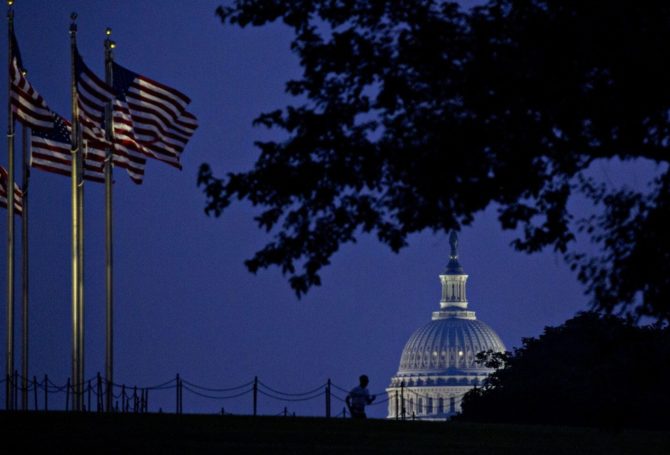
“Congress is not fulfilling its constitutional duties.” Any number of people could make that claim. It is extraordinary that 70 former US senators, including four Republican senators from the Pacific Northwest, made the claim in an open letter published last week by The Washington Post.
The 70 former senators, including Dan Evans and Slade Gorton of Washington and Bob Packwood and Gordon Smith of Oregon, said, “We are writing to encourage the creation of a bipartisan caucus of incumbent senators who would be committed to making the Senate function as the Framers of the Constitution intended.”
A dysfunctional Congress, the senators wrote, has ceded power to the “less democratic executive and judicial branches” on issues such as international trade, use of military force, declaring national emergencies and the “power of the purse”. “Partisan gridlock,” they added, has become routine and, in turn, permitted the executive branch to assume legislative duties through executive orders and administration regulation.
Singling out the upper chamber in which they formerly served, the senators said, “The Senate’s abdication of its legislative and oversight responsibilities erodes the checks and balances of the separate powers that are designed to protect the liberties on which our democracy depends.” They pointed to the loss responsibility to write bills by Senate committees and the filibuster.
“Rules allowing extended debate, a feature of the Senate that is essential to protecting the rights of minorities, have been abused as the filibuster and cloture have shut down action on the Senate floor. It is now commonly said that it takes 60 votes to pass anything in the Senate,” the senators wrote.
They recommend a solution. “We believe a bipartisan caucus of incumbent members that promotes a fair opportunity for senators to participate in meaningful committee work as well as on the Senate floor could help restore the Senate to its essential place in our constitutional system. Its members would need to stand firm in the face of what could be strong opposition from partisans who prefer politicians who take intransigent positions over those who champion a legislative process that celebrates compromise.”
Forty-eight of the signers are Democrats, 18 are Republicans and four are independents. Only one of the signers, former Senator Tom Daschle, D-South Dakota, served in Senate leadership positions as both majority and minority leader. The signers include high-profile former senators such as John Kerry, Alan Simpson, Joe Lieberman and Bill Bradley and a several who chaired powerful Senate committees.
After serving three terms as governor, Evans represented Washington in the Senate from 1983 to 1989. Gorton, who served three terms as Washington’s attorney general, won a Senate seat in 1980 by defeating Warren Magnuson, then the chairman of the Senate Appropriations Committee, opening up the influential position for Oregon Senator Mark Hatfield. Gorton lost his re-election bid in 1986, but he won election to Washington’s other Senate seat in 1988. Gorton lost his bid for re-election in 2000 to Democrat Maria Cantwell, who continues to serve.
Packwood earned his Oregon Senate seat in 1968 when he defeated incumbent Democrat Wayne Morse following his vote to oppose the Tonkin Gulf Resolution. Packwood served in the Senate for 26 years and is best known for passage of major tax reform legislation in 1984. Smith was elected to the Senate in 1996 and served for two terms. He lost his first bid for the US Senate to Ron Wyden, who is now Oregon’s senior senator. Smith was defeated in his 2008 bid for re-election by Jeff Merkley, who remains in the Senate.
The 70 senators who weighed on Senate reform took care not to level criticism at current Senate Majority Mitch McConnell, who often is the target of slings and arrows from Democrats who refer to him as the “grim reaper” because he has blocked hundreds of Democratic legislative measures.
“[The open letter] does not have to be viewed as a judgment on today’s Senate leadership; instead, it’s a bipartisan act of shared responsibility and accountability for how we arrived at this point. We, who once held the office you now hold and who are confident that service in the US Senate is as high a calling for you as it was for us, will stand up for you against any partisan opposition. We will do so publicly and repeatedly in whatever available forums. And we are convinced that many ordinary Americans will stand up for you as well, as they share our concern for the state of our government.”

Reforming the Senate is hardly a new topic. In Frank Capra’s 1939 political classic Mr. Smith Goes to Washington, the rookie senator played by Jimmy Stewart mounts a filibuster to block an appropriations bill to build a dam on land proposed for a national boys’ camp. Stewart’s filibuster required him to stay on the Senate floor and speak for hours. Nowadays, all senators have to do is file a motion and leave for lunch in the Senate dining room.
The late John Dingell, the longest serving Member of Congress, suggested abolishing the Senate or at least combining it with the House as a way to “end minority rule” in the legislative branch. Senator Elizabeth Warren in her campaign for the presidency has called for the end of the filibuster, which she claims has perpetuated “economic inequality and racism.”
Senate Republicans voted in 2017 to excuse presidential nominees from filibuster procedures. Known as the “nuclear option,” the rule change was approved on a simple majority, party-line vote by Senate Republicans over Democratic objections. The rule change smoothed the way for the confirmation of Supreme Court Justices Neil Gorsuch and Brett Kavanaugh. Former Democratic Senate Majority Leader Harry Reid introduced the nuclear option in 2013 to speed Senate confirmation of lower court and executive brand nominees by President Obama in the face of a record-number of filibuster threats by Senate Republicans.

Brief History of the Senate Filibuster and Cloture
Majority rule was the consensus view of voting in the House and Senate for decades. The Federalist Papers warned against supermajority requirements, except for impeachment, expelling members, approving treaties and proposing constitutional amendments, as a way for a minority to thwart a majority.
Contrary to what many people think, the filibuster does not have a constitutional basis. It came about accidentally. The first US Senate in 1789 approved rules allowing senators to move the previous question to end debate. In 1806, then presiding officer Aaron Burr argued successfully to scrap the seldom-used parliamentary procedure. No one thought about replacing it with something else to end debates.
The filibuster, which theoretically was possible in both the House and Senate, was first employed in 1937 and became prominent in 1841 when Senator Henry Clay tried to end debate on legislation to charter the Second Bank of the United States, but he backed down in the face of a threatened filibuster.
During World War I, a cloture rule was approved after anti-war senators managed to scuttle a bill to allow President Woodrow Wilson to arm merchant vessels that were being attacked by German submarines. It was a bittersweet achievement for Wilson when a subsequent cloture vote led to the defeat of the Treaty of Versailles.
In the 1930s, Dixiecrats exploited the filibuster to block anti-discrimination measures. Senator Strom Thurmond filibustered for more than 24 hours to stop the 1957 Civil Rights Act. Oregon Senator Wayne Morse once filibustered for more than 22 hours to protest oil legislation.
The current 60-vote cloture rule dates back to the 1970s when Democratic Majority Leader Mike Mansfield and Majority Whip Robert Byrd devised a two-track system that permitted two bills to be under consideration simultaneously on the Senate floor. That move had the unintended effect of making filibuster easier to threaten without slowing down the work of the Senate.
Attempts to abolish the filibuster for judicial nominees began in 2005 when the “nuclear option” was first discussed to allow confirmation by a simple majority. Democratic Senate Majority Leader Harry Reid used the nuclear option in 2013 to speed confirmation of Obama nominees for judicial and executive positions, except the Supreme Court. In 2017, Republican Senate Majority Leader Mitch McConnell expanded the nuclear option for all judicial positions, including Supreme Court justices.



